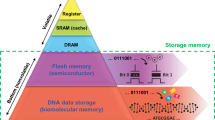Abstract
Embryonics is a long-term research project attempting to draw inspiration from the biological process of ontogeny, to implement novel digital computing machines endowed with better fault-tolerant capabilities. For this purpose FPGAs are extremely useful. However, through this project we designed MuxTree, a new coarse-grained FPGA, to implement our embryonic machines. This article focuses on the issues posed by the memory storage and the advances made to achieve more robust memory structures.
Access this chapter
Tax calculation will be finalised at checkout
Purchases are for personal use only
Preview
Unable to display preview. Download preview PDF.
Similar content being viewed by others
References
Barbieri, M.: The Organic Codes: The Basic Mechanism of Macroevolution. Rivista di Biologia / Biology Forum 91 (1998) 481–514.
Gilbert, S. F.: Developmental Biology. Sinauer Associates Inc., MA, 3rd ed. (1991).
Mange, D., Tomassini, M., eds.: Bio-inspired Computing Machines: Towards Novel Computational Architectures. Presses Polytechniques et Universitaires Romandes, Lausanne, Switzerland (1998).
Mange, D., Sanchez, E., Stauffer, A., Tempesti, G., Marchal, P., Piguet, C.: Embryonics: A New Methodology for Designing Field-Programmable Gate Arrays with Self-Repair and Self-Replicating Properties. IEEE Transactions on VLSI Systems, 6(3), (1998) 387–399.
Negrini, R., Sami, M. G., Stefanelli, R.: Fault Tolerance Through Reconfiguration in VLSI and WSI Arrays. The MIT Press, Cambridge, MA (1989).
Ortega, C., Tyrrell, A.: Reliability Analysis in Self-Repairing Embryonic Systems. Proc. 1st NASA/DoD Workshop on Evolvable Hardware, Pasadena, CA (1999) 120–128.
Shibayama, A., Igura, H., Mizuno, M., Yamashina, M.: An Autonomous Reconfigurable Cell Array for Fault-Tolerant LSIs. Proc. 44th IEEE International Solid-State Circuits Conference, San Francisco, CA (1997) 230–231, 462.
Sipper, M.: Fifty Years of Research on Self-Replication: an Overview. Artificial Life, 4(3) (1998) 237–257.
Tempesti, G.: A Self-Repairing Multiplexer-Based FPGA Inspired by Biological Processes. Ph.D. Thesis No. 1827, EPFL, Lausanne (1998).
Tempesti, G., Mange, D., Stauffer, A.: Self-Replicating and Self-Repairing Multicellular Automata. Artificial Life, 4(3) (1998) 259–282.
Wolfram, S.: Theory and Applications of Cellular Automata. World Scientific, Singapore (1986).
Wolpert, L.: The Triumph of the Embryo. Oxford University Press, New York (1991).
Sipper, M., Sanchez, E., Mange, D., Tomassini, M., Perez-Uribe, A., Stauffer, A.: A Phylogenetic, Ontogenetic, and Epigenetic View of Bio-Inspired Hardware Systems. IEEE Transactions on Evolutionary Computation, 1(1) (1997) 83–97.
Prodan, L., Tempesti, G., Mange, D., Stauffer, A.: Biololy Meets Electronics: The Path to a Bio-Inpired FPGA. Proc. 3rd International Conference on Evolvable Systems: From Biology to Hardware, Edinburgh, Scotland, UK (2000) 187–196.
Terry, T. M.: http://www.sp.uconn.edu/~bi107vc/fa99/terry/DNA.html
Author information
Authors and Affiliations
Editor information
Editors and Affiliations
Rights and permissions
Copyright information
© 2001 Springer-Verlag Berlin Heidelberg
About this paper
Cite this paper
Prodan, L., Tempesti, G., Mange, D., Stauffer, A. (2001). Embryonics: Artificial Cells Driven by Artificial DNA. In: Liu, Y., Tanaka, K., Iwata, M., Higuchi, T., Yasunaga, M. (eds) Evolvable Systems: From Biology to Hardware. ICES 2001. Lecture Notes in Computer Science, vol 2210. Springer, Berlin, Heidelberg. https://doi.org/10.1007/3-540-45443-8_9
Download citation
DOI: https://doi.org/10.1007/3-540-45443-8_9
Published:
Publisher Name: Springer, Berlin, Heidelberg
Print ISBN: 978-3-540-42671-4
Online ISBN: 978-3-540-45443-4
eBook Packages: Springer Book Archive




